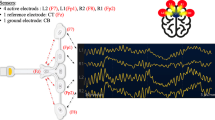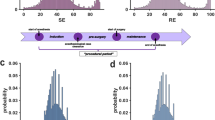Summary
A computer system, based on IBM PC, was designed for the cerebrospinal compensatory model identification. The intracranial pressure (ICP) signal, registered during the lumbo-lumbar infusion test is analyzed by means of the spectral analysis algorithm in order to measure precisely the pulse wave amplitude. The amplitude and the mean ICP level, calculated repetetively within the period of about 8 seconds, are stored on the disk and form the basis for further model identification. Three different methods of identification were applied. They enable one to estimate the fundamental model parameters, such as: resistance to the cerebrospinal fluid resorption, pressure-volume index, baseline pressure, rate of formation of the cerebrospinal fluid.
Statistical evaluation of the results of the infusion test analysis obtained by means of the system described in two groups of hydrocephalic patients (children and adults) is presented.
Similar content being viewed by others
References
Avezaat CJJ, Eijndhoven JHM van (1984) Cerebrospinal fluid pressure and craniospinal dynamics. Thesis. Erasmus University Rotterdam
Borgensen SE, Gjerris F (1982) The predictive value of conductance to outflow of CSF in normal pressure hydrocephalus. Brain 105: 65–86
Eijndhoven JHM van, Sliwka S, Avezaat CJJ (1986) The constant pressure term of the volume-pressure relationship. Comparison between results of infusion test and pulse pressure analysis. In: Miller JD, Teasdale GM, Rowan JOet al (eds) Intracranial pressure VI. Springer, Berlin Heidelberg New York, pp 48–53
Ekstedt J (1977) CSF hydrodynamic studies in man. Method of constant pressure CSF infusion. J Neurol 40: 2, 105
Junck L (1986) Benign intracranial hypertension and normal pressure hydrocephalus. Theoretical considerations. In: Miller JD, Teasdale GM, Rowan JOet al (eds) Intracranial pressure VI. Springer, Berlin Heidelberg New York, pp 447–451
Kunzel B von, Klages G, Meier U (1987) Der intrathekale Infusionstest zur Untersuchung der kraniospinalen Liquordynamik. Ein neues Auswerteverfahren. Zbl Neurochir 48: 320–326
McComb JG (1983) Recent research into nature of cerebrospinal fluid formation and absorption. J Neurosurg 59: 369–383
Sliwka S (1980) A clinical system for evaluation of selected dynamic properties of the intracranial system. Academy of Sciences, Warsaw (in Polish)
Wocjan J, Roszkowski M. Sliwka Set al (1986) Analysis of CSF dynamics by computerized pressure-elastance resorption test in hydrocephalic children. Child's Nerv System 2: 98–100
Author information
Authors and Affiliations
Rights and permissions
About this article
Cite this article
Czosnyka, M., Batorski, L., Laniewski, P. et al. A computer system for the identification of the cerebrospinal compensatory model. Acta neurochir 105, 112–116 (1990). https://doi.org/10.1007/BF01669992
Issue Date:
DOI: https://doi.org/10.1007/BF01669992




